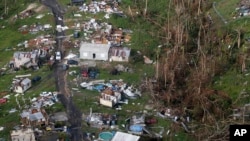Howling winds, deadly floods, fire and ice so far this year have pushed the U.S. into a tie for weather disasters that topped $1 billion in damage.
There have been 15 costly disasters through September, tying 2011 for the most billion-dollar weather disasters for the first nine months of a year. The record for a year is 16, and the hurricane season is not over yet.
2017 unprecedented?
The figures released Friday by the National Oceanic and Atmospheric Administration include three hurricanes, three tornado outbreaks, four severe storms, two floods, a drought, a freeze and wildfires.
NOAA climate scientist Adam Smith said 2017 is shaping up to be an unprecedented year. It is likely to tie or break the record for billion-dollar weather disasters that was set in 2005, the year of Hurricane Katrina and other deadly storms.
NOAA hasn’t calculated the costs from Hurricanes Harvey, Irma and Maria, but an outside disaster risk company estimates the U.S. damage from the three hurricanes to be around $150 billion. The remaining disasters so far this year have cost more than $21.7 billion and killed 282 people, according to NOAA.
Damage figures are adjusted for inflation; records for billion-dollar disasters go back to 1980.
Climate change
Between 1980 and 2007, the U.S. averaged only four billion-dollar disasters per year. In the decade since, the country has averaged 11 per year.
Experts blame a combination of factors.
“Climate change is impacting extreme weather in ways we hadn’t anticipated,” Michael Mann of Pennsylvania State University said in an email.
But an even bigger factor is that more people moving into harm’s way “has created massive amounts of exposure in regions prone to severe weather events,” said Mark Bove, a meteorologist at insurance giant Munich Re.





